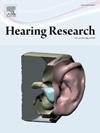人工耳蜗使用者噪音中的听觉工作记忆:来自行为和神经元测量的见解。
IF 2.5
2区 医学
Q1 AUDIOLOGY & SPEECH-LANGUAGE PATHOLOGY
引用次数: 0
摘要
目的:利用行为测量和脑电图(EEG)研究具有不同程度人工耳蜗(CI)表现的成人耳蜗使用者的听觉工作记忆。方法:24名成年CI听众(年龄:M = 61.38, SD = 12.45)执行Sternberg工作记忆听觉数字任务,在此过程中捕获EEG,准确性和敏捷性。在信噪比(SNR)为0、+5和+10dB的情况下,向参与者呈现2、4或6个数字。他们必须在前面的序列中识别一个探针刺激。方差分析模型用于比较条件。结果:方差分析显示,记忆负荷增加导致任务绩效下降,CI绩效与记忆负荷和信噪比相互作用。在记忆编码过程中,中央-顶叶α能量增加,但在不同条件下没有差异。在受信噪比影响最大的条件下,额叶α功率与准确率呈显著正相关(r = 0.57, r = 0.52);在受ML影响最大的条件下,额叶α功率与准确率呈显著正相关(r = 0.55, r = 0.57)。结论:虽然顶叶α能量受到任务的调节,但在这组CI听众中,额叶α能量与加工的感觉方面(噪音)和额叶θ能量与记忆负荷在数量上相关。意义:这些结果表明,α和θ与行为有明显的关系,为CI用户的神经认知(听觉工作记忆)过程提供了额外的见解。本文章由计算机程序翻译,如有差异,请以英文原文为准。
Auditory working memory in noise in cochlear implant users: Insights from behavioural and neuronal measures
Objective
We investigated auditory working-memory using behavioural measures and electroencephalography (EEG) in adult Cochlear Implant (CI) users with varying degrees of CI performance.
Methods
24 adult CI listeners (age: M = 61.38, SD = 12.45) performed the Sternberg auditory-digit-in-working-memory task during which EEG, accuracy, and promptness were captured. Participants were presented with 2, 4, or 6 digits at Signal-to-Noise Ratios (SNR) of 0, +5 and +10dB. They had to identify a probe stimulus as present in the preceding sequence. ANOVA models were used to compare conditions.
Results
ANOVA revealed that increasing memory load (ML) led to decreased task performance and CI performance interacted with ML and SNR. Centro-parietal alpha power increased during memory encoding but did not differ between conditions. Frontal alpha power was positively correlated with accuracy in conditions most affected by SNR (r = 0.57, r = 0.52) and theta power in conditions most affected by ML (r = 0.55, r = 0.57).
Conclusions
While parietal alpha power is modulated by the task, it is frontal alpha that relates quantitatively to sensory aspects of processing (noise) and frontal theta to memory load in this group of CI listeners.
Significance
These results suggest that alpha and theta show distinct relationships to behaviour, providing additional insight into neurocognitive (auditory working-memory) processes in CI users.
求助全文
通过发布文献求助,成功后即可免费获取论文全文。
去求助
来源期刊

Hearing Research
医学-耳鼻喉科学
CiteScore
5.30
自引率
14.30%
发文量
163
审稿时长
75 days
期刊介绍:
The aim of the journal is to provide a forum for papers concerned with basic peripheral and central auditory mechanisms. Emphasis is on experimental and clinical studies, but theoretical and methodological papers will also be considered. The journal publishes original research papers, review and mini- review articles, rapid communications, method/protocol and perspective articles.
Papers submitted should deal with auditory anatomy, physiology, psychophysics, imaging, modeling and behavioural studies in animals and humans, as well as hearing aids and cochlear implants. Papers dealing with the vestibular system are also considered for publication. Papers on comparative aspects of hearing and on effects of drugs and environmental contaminants on hearing function will also be considered. Clinical papers will be accepted when they contribute to the understanding of normal and pathological hearing functions.
 求助内容:
求助内容: 应助结果提醒方式:
应助结果提醒方式:


